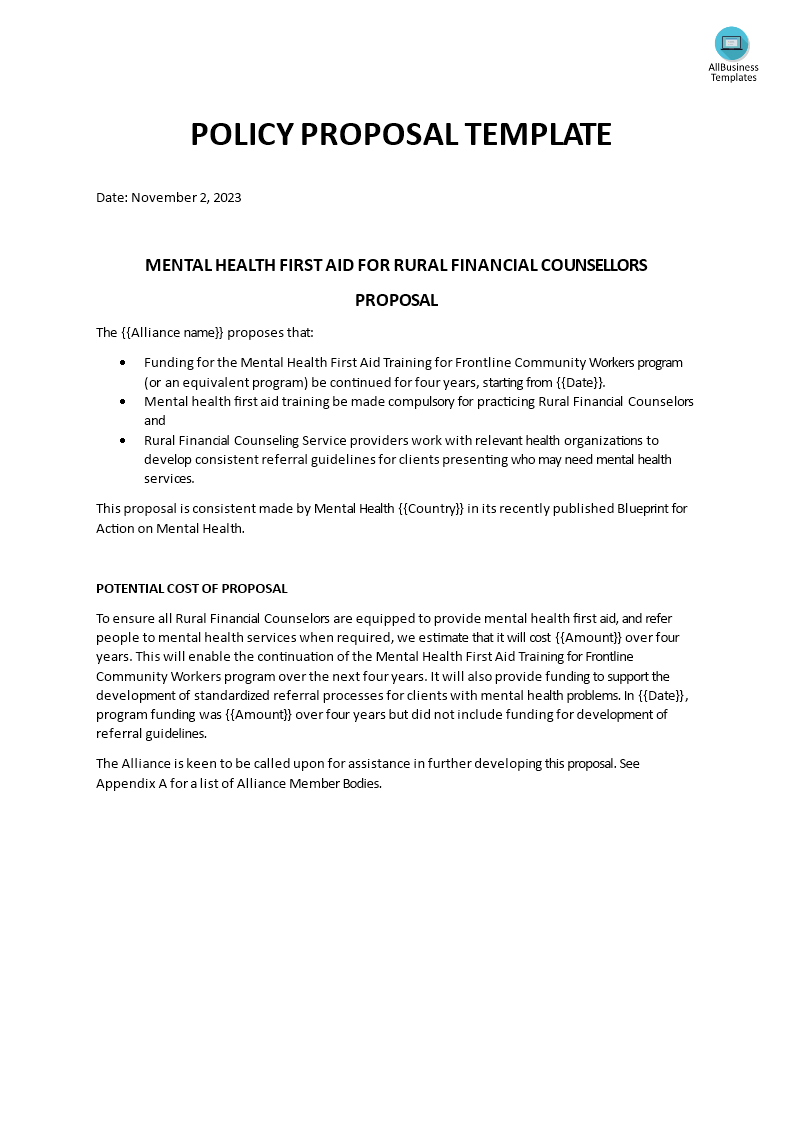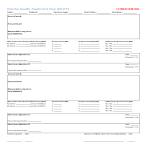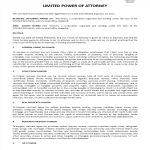Policy Proposal Template
Save, fill-In The Blanks, Print, Done!

Download Policy Proposal Template
Microsoft Word (.docx)Or select the format you want and we convert it for you for free:
- This Document Has Been Certified by a Professional
- 100% customizable
- This is a digital download (32.51 kB)
- Language: English
- We recommend downloading this file onto your computer.
How to write a policy proposal template? What are the steps to writing a policy proposal? This template will help you create a clear and concise policy proposal that outlines the objectives and goals of your policy, as well as the necessary steps to achieve them. Download now to get started.
A policy proposal is a formal document that outlines and presents a suggested plan of action or a set of guidelines for addressing a specific issue or problem. It is typically developed by individuals or organizations, such as government agencies, advocacy groups, businesses, or researchers, with the aim of influencing decision-makers, policymakers, or stakeholders to adopt or change policies, regulations, or practices in a particular area. Policy proposals are an essential component of the policymaking process and are used to provide comprehensive solutions to various societal, economic, or political challenges.
Key components of a policy proposal may include:
- Problem Statement: Clearly define the issue or challenge that the proposal aims to address. This includes providing background information, data, and evidence to support the claim that action is needed.
- Objectives: Setting out the specific goals and outcomes the proposed policy seeks to achieve.
- Rationale: Explain why the proposed policy is necessary and how it will address the identified problem. This often involves presenting research, expert opinions, and cost-benefit analysis.
- Policy Recommendations: Outlining the actual policy changes or actions that should be taken, including specific measures, regulations, or legislation to be implemented.
- Implementation Plan: Detailing the steps and strategies for putting the proposed policy into action, including a timeline, responsible parties, and resource allocation.
- Evaluation and Monitoring: Describing how the policy's effectiveness will be assessed and what metrics will be used to measure its impact.
- Budget and Funding: Specifying the financial requirements of implementing the policy and how it will be funded.
- Stakeholder Analysis: Identifying and addressing the interests, concerns, and potential impacts on various stakeholders, such as affected groups, businesses, and the broader community.
- Legal and Ethical Considerations: Discuss any legal or ethical issues associated with the proposed policy and how they will be managed.
- Conclusion: Summarize the key points of the proposal and make a persuasive case for its adoption.
Policy proposals can vary significantly in scope and complexity. They are often used in various domains, including public policy, healthcare, education, environmental issues, and business. Successful policy proposals are usually well-researched, well-documented, and persuasive, with a focus on demonstrating the feasibility and benefits of the proposed policy changes.
Download this health care Policy Proposal Template now!
Also interested in other health and healthcare templates? Just search on our search bar or browse through our thousands of free and premium health forms and templates, contracts, documents, letters, etc., which are used by professionals in the healthcare industry.
DISCLAIMER
Nothing on this site shall be considered legal advice and no attorney-client relationship is established.
Leave a Reply. If you have any questions or remarks, feel free to post them below.
Related templates
Latest templates
Latest topics
- Google Sheets Templates
How to work with Google Sheets templates? Where to download useful Google Sheets templates? Check out our samples here. - Letter Format
How to format a letter? Here is a brief overview of common letter formats and templates in USA and UK and get inspirited immediately! - IT Security Standards Kit
What are IT Security Standards? Check out our collection of this newly updated IT Security Kit Standard templates, including policies, controls, processes, checklists, procedures and other documents. - Excel Templates
Where do I find templates for Excel? How do I create a template in Excel? Check these editable and printable Excel Templates and download them directly! - Google Docs Templates
How to create documents in Google Docs? We provide Google Docs compatible template and these are the reasons why it's useful to work with Google Docs...
cheese




